Explore the growing mobile landscape in Chile today.
January 10, 2025
Written by Turian Biel

Table of Contents
Mobile Phone Usage and Trends in Chile
Overview of Mobile Phone Penetration in Chile
In Chile, mobile phone penetration reached over 90% in 2024, indicating a significant reliance on mobile technology among the population. As of 2023, there are approximately 26.70 million mobile phone subscribers, translating to about 134.75 subscribers per 100 people. The mobile phone market share is led by Samsung with 33.22%, followed by Apple at 22.61%. Furthermore, 85% of Internet accesses in Chile are through mobile devices. The average cost of mobile data ranges from CLP 5,000 to CLP 20,000, depending on the data package.

Growth of Smartphone Users in Chile
As of March 2024, there are approximately 19.8 million smartphone users in Chile, representing a penetration rate of 104.3% of the population. The total number of smartphone users was 15.01 million in 2022 and is expected to reach 19.26 million by 2029. In 2022, mobile data usage increased by 33% over the national average, driven by the rollout of the 5G network. Additionally, smartphone shipments in Chile increased by 71% YoY in 2022.
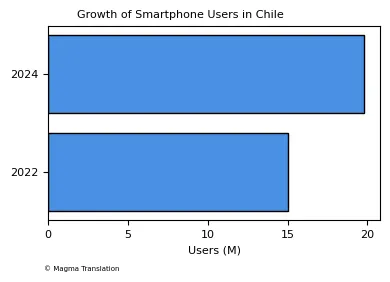
Mobile Internet Usage Statistics
In 2022, 58% of e-commerce purchases in Chile were made with a mobile device. Furthermore, 66% of e-commerce volume comes from purchases made with mobile devices. The average mobile internet speed in Chile is 38.30 Mbps, with a median download speed of 171.6 Mbps for 5G connections. As of 2023, 26.70 million mobile phone subscribers were recorded, indicating a high level of connectivity.
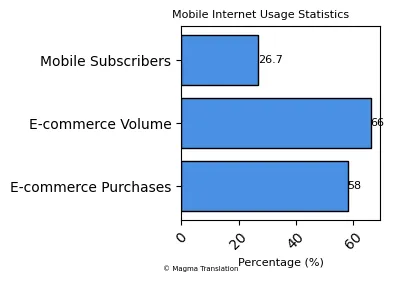
Mobile Payment Trends in Chile
In Chile, 19% of mobile phone subscribers have a mobile money account. Additionally, 30.5% use their data for video streaming, while 28.8% use it for social networking. The mobile advertising market in Chile is projected to reach US$535.7 million by 2028, with 71% of total ad spending expected to be generated through mobile by that year.
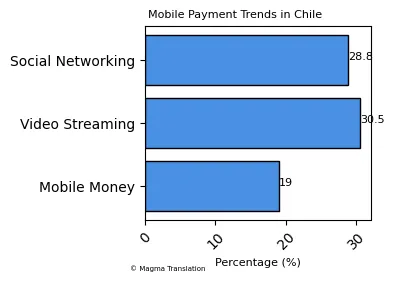
Mobile Network Coverage and Quality
Chile has a robust mobile network infrastructure, with coverage including 2G, 3G, 4G, and 5G technologies. The average download speed for Entel is 13.3 Mbps, while Claro experiences a 65% slow-down during peak hours. As of 2023, 131.7 mobile phone subscribers for every 100 inhabitants were reported, totaling 26.3 million subscribers.

Impact of Mobile Technology on Daily Life
Mobile phones are essential tools for accessing health information in Chile, reflecting a broader trend of mobile technology integration into daily life. In 2022, 4.00 GB of data traffic per smartphone was recorded, with an expected CAGR of 12.67% during the forecast period. Moreover, 91% of the population owns a cell phone, highlighting the importance of mobile connectivity in everyday life.
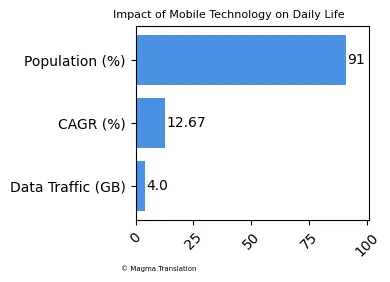
Future Projections for Mobile Phone Usage
Looking ahead, the mobile phone market in Latin America, including Chile, is expected to see significant growth, with a forecast of over 40 million units shipped in 2024. The Chile Smartphone Market is projected to grow at a CAGR of around 6.5% during the forecast period, 2023-2028. Additionally, the mobile data segment in Chile will be the largest revenue contributor in 2023, accounting for 37.8% of the total telecom service revenue.

Challenges in Mobile Connectivity
Despite the high penetration rates, challenges remain in mobile connectivity across rural areas in Chile. The transition to 5G is still increasing due to the expanding demand for high-speed connectivity services. Furthermore, Chile has the highest penetration of mobile connections in the region at 147 percent, but disparities in service quality persist.
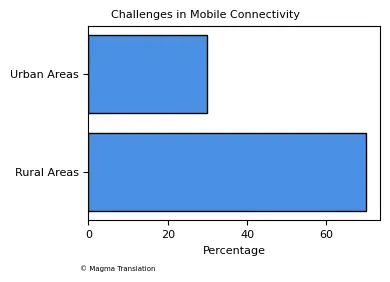
Mobile Phone Demographics and User Behavior in Chile
Demographics of Mobile Phone Users
In Chile, mobile phone usage is prevalent across various age groups. As of 2023, 55% of 18-29 year-olds own a smartphone, while overall, 68% of phone subscriptions are pre-paid. The total number of active phone subscriptions in Chile is 25.8 million, indicating that every Chilean could be thought to own 1.4 devices. Additionally, 12 million use their mobile phones to access social media platforms, showcasing the importance of mobile connectivity in social interactions.
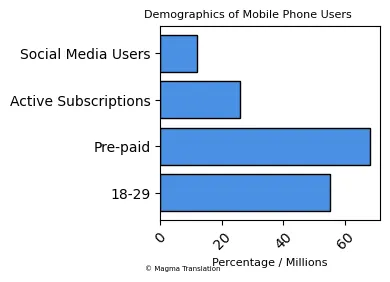
Mobile Data Consumption Trends
Mobile data consumption in Chile has seen significant growth. In 2022, the total data traffic per smartphone was 4.00 GB, with projections indicating an increase to 9.22 GB by 2029. The average mobile internet speed is 38.30 Mbps, which supports the growing demand for data-intensive applications. Furthermore, 40% of online purchases are completed using a mobile device, reflecting the increasing reliance on mobile for e-commerce.

Mobile Network Providers and Competition
Chile's mobile network market is competitive, with major providers including Movistar, Entel, and Claro. As of 2023, 131.7 mobile phone subscribers for every 100 inhabitants were reported, totaling 26.3 million subscribers. Entel delivers Chile’s fastest mobile network experience with an average download speed of 13.3 Mbps, while Claro experiences a 65% slow-down during peak hours. This competition drives improvements in service quality and pricing for consumers.

Impact of 5G Technology in Chile
The rollout of 5G technology in Chile is transforming mobile connectivity. As of December 2023, the number of 5G connections reached 3.8 million, reflecting a growth of 88.5% compared to the previous year. The average access speed of 5G in Chile is 171.6 Mbps, significantly faster than 4G speeds. This advancement is expected to enhance mobile applications and services, further integrating mobile technology into daily life.
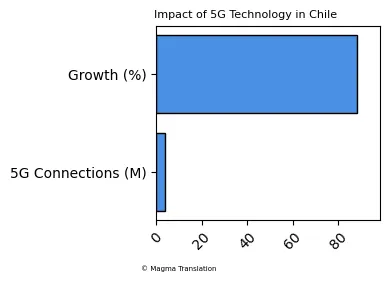
Challenges in Mobile Connectivity and Access
Despite high mobile penetration rates, challenges remain in mobile connectivity, particularly in rural areas. The transition to 5G is ongoing, with Chile having the highest penetration of mobile connections in the region at 147 percent. However, disparities in service quality persist, especially in less populated regions. Addressing these challenges is crucial for ensuring equitable access to mobile technology across the country.
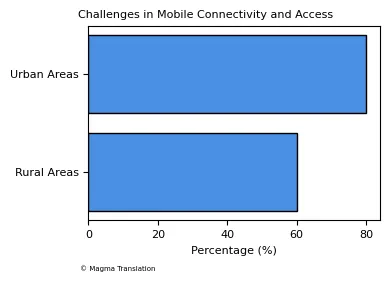
Mobile Phone Security and Privacy Concerns in Chile
Security Measures for Mobile Users
As mobile phone usage increases in Chile, so do concerns regarding security and privacy. In 2022, 91% of the population owns a cell phone, making it essential for users to adopt security measures. Many Chileans utilize mobile banking, with 19% of mobile phone subscribers having a mobile money account. However, the rise in mobile transactions has also led to an increase in cyber threats, prompting users to be vigilant about their online activities and personal information.
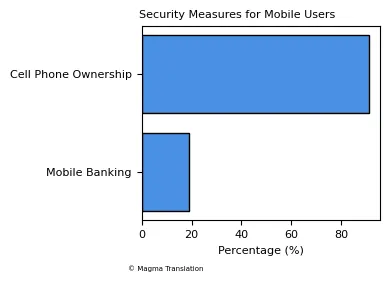
Privacy Regulations and User Awareness
In response to growing privacy concerns, Chile has implemented regulations to protect users. The government has introduced laws aimed at enhancing data protection for mobile users. Despite these efforts, 25% of mobile users in Chile regularly access consumer information, highlighting the need for increased awareness regarding privacy practices. Educating users about secure mobile practices is crucial for safeguarding personal data in an increasingly digital landscape.
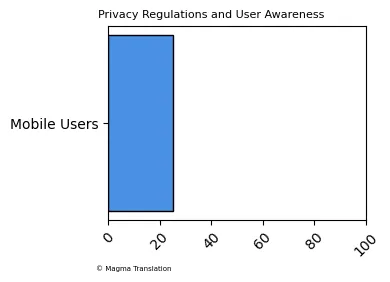
Mobile Phone Security and Privacy Concerns
Security Challenges in Mobile Usage
As mobile phone usage increases in Chile, so do concerns regarding security and privacy. A significant portion of users, approximately 91% of the population owns a cell phone, making them potential targets for cyber threats. Reports indicate that 12 million Chileans use their mobile phones to access social media platforms, which can expose them to privacy risks. Additionally, 19% of mobile phone subscribers have a mobile money account, highlighting the need for secure transactions. Users are encouraged to adopt security measures to protect their personal information.
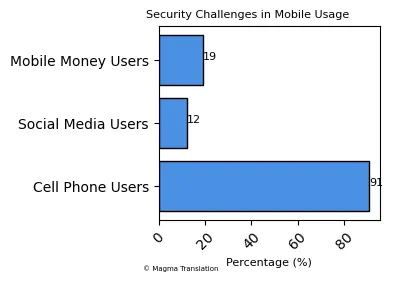
Regulatory Framework for Mobile Security
The Chilean government has implemented regulations to enhance mobile security and protect user data. The high penetration of mobile connections necessitates robust security frameworks. As mobile technology evolves, regulations are being updated to address emerging threats. The government aims to ensure that mobile service providers adhere to security standards, thereby safeguarding users' privacy and data integrity. Continuous awareness campaigns are also essential to educate users about potential risks and best practices for mobile security.
Conclusion
Mobile phone usage in Chile reflects a dynamic landscape with significant growth and challenges. Understanding these trends is crucial for users and policymakers alike.
